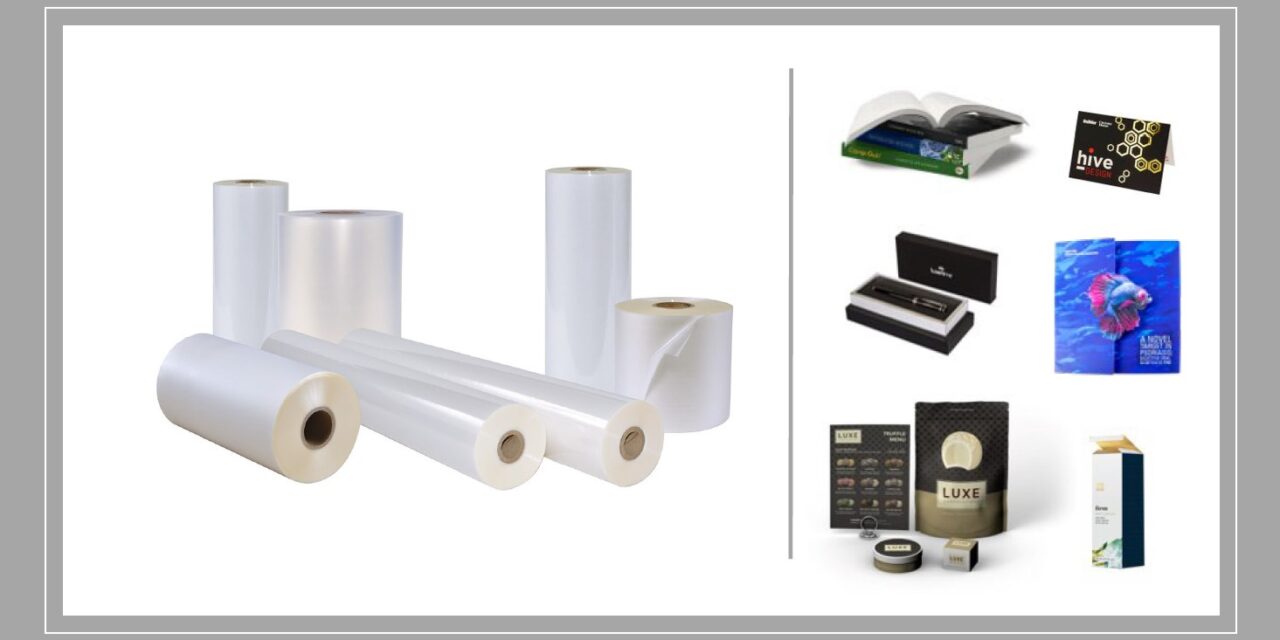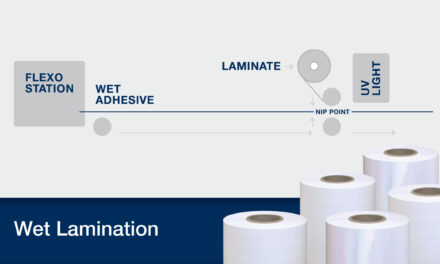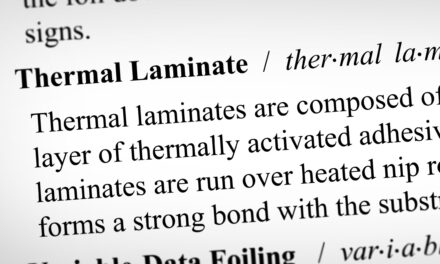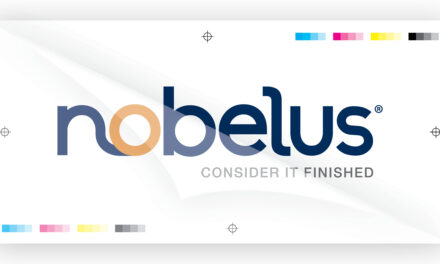The Reach of Lamination and Laminating Films
When the average person hears the word “lamination,” they most likely picture a shiny sheet of plastic-enclosed paper with a clear, thin rim around the sides that has been hung up as a reference document in a school or office. It can seem like lamination serves a singular purpose: keep paper from being torn up or thrown away. However, lamination and laminating films cover far more ground than most people realize, and many of the printed pieces we interact with daily are laminated without anyone noticing.
Lamination can be used as a subtle way to elevate the practical and aesthetic performance of products in a variety of markets, including sales collateral, print publications, pet products, and specialty foods. Even the prime labels and flexible packaging so common on store shelves often benefit from some form of lamination. Thermal laminates and unsupported films come in a wide variety of materials, special effects, and textured finishes that can completely transform a simple piece of paper into a work of art that enhances the customer experience and signifies the quality of the product it accompanies.
An Overview of Thermal Laminates and Unsupported Films
Laminating films in the Nobelus® catalog come in two forms: thermal laminates and unsupported films. While they are similar in many ways, their key distinction lies in how and in what situations they are applied to a substrate.
- Thermal laminates are designed for laminators that make use of heated nip rollers. These laminates are coated in an adhesive layer that melts when heated to ensure the laminate achieves a strong bond with whatever substrate it is pressed against. Our traditional EVA adhesive is compatible with conventional offset, flexographic, and HP® Indigo presses. For presses that use dry toner or fuser oils, including many digital presses, we offer laminates with a DigiBOND™ adhesive layer that is specifically designed for these outputs.
- Unsupported films are engineered specifically for prime label and flexible packaging applications. These films have no adhesive often making them more cost effective than other types of pressure-sensitive, self-wound laminate films. Producers of these applications have many options on how to apply unsupported films using existing flexographic equipment and wet adhesives with minimal adjustments to the production workflow.
Both thermal laminates and unsupported films come in a range of material types and finishes. Nobelus is constantly seeking out new finishes and material types to ensure every customer has access to the products they need. The base material of a laminate affects everything from its durability to how efficiently it can run through a laminator. Many materials are available in several thicknesses, which helps determine which applications the laminate is suitable for. Finishes can range from basic gloss and matte to luxurious soft-touch textures and holographic effects.
The Benefits of Lamination and Laminating Films
With the full scope of lamination in mind, let’s take a look at some of the top reasons laminates are so widely used in customer-facing prints and packaging. Rather than ranking these points in terms of importance, we’ll start out small scale and gradually build to look at the bigger picture: How can laminates add value to your prints?
1. Laminating Films Increase the Lifespan of Prints
Considering how much time and effort graphic designers, printers, and manufacturers put into projects that use paper, the material is infamously fragile and can be scuffed, bent, or torn easily. Laminates keep dirt, grease, and oil from making contact with the substrate, and certain finishes, such as gloss, can even be wiped down with a cleaner and disinfected to prevent the spread of germs or unpleasant residue.
These qualities make laminated paper perfect for frequently touched items, such as menus, brochures, and cards. As a general rule, any paper that has been laminated with a polypropylene- or polyester-based laminate will see improved durability and strength with regular use. Because laminating films are made of plastic, they help prevent moisture from warping or dissolving the substrate. Any application that hopes to make use of paper for repeated or long-term applications will need a laminate to preserve its integrity.
2. Lamination Protects Ink and Designs
Exposed inks can be smeared or rubbed off when a piece is handled too often. This is especially true for digital inks, which tend to be softer than their conventional counterparts. Laminates provide a protective layer over these carefully designed pieces to ensure each detail remains sharp and retains its full color clarity regardless of how many hands it passes through. Certain finishes, like ScuffProof®, will prevent friction and regular use from scraping off parts of the design. Options like our SmudgeProof™ Laminate keep fingerprints and streaks from leaving behind unappealing blemishes.
Chemicals and sunlight can also negatively impact ink without a UV-blocking laminate in place to protect it. When this happens, the ink may grow dull or fade over time, which harms the tonality of the piece, makes the designs less striking, and affects the readability of text. Laminates also provide a barrier against water droplets and humidity that could otherwise weaken the bond between the ink and the paper substrate.
3. Laminates Add an Aesthetic Appeal
Even in the age of online shopping, brands are in heated competition for shelf space. The first thing a customer notices when scanning products on a shelf is their physical appearance, so it is vital to draw in customers at first glance. Graphic designs will obviously have a huge effect on the look of packaging, but laminates can enhance an item’s appeal in ways ink and coatings can’t. On a practical level, laminates prevent cartons and other bent or folded packaging from developing unseemly cracks on corners and curves. A gloss laminate will add vibrancy and make colors pop while adding a professional quality to average paper. Certain finishes, such as the aptly named matte laminates, provide a non-reflective matte effect to prevent words and images from being obscured by glare from bright lights.
Laminates can also amplify designs in a myriad of ways. Tactility is more requested than ever, and Karess® soft-touch laminate immediately stands out when a customer feels it due to its luxurious haptic effect, which leads the customer to consider why the product’s packaging feels so different from the other options. For prints that need to convey a sense of intrigue or mystery, Rainbow Holografik™ has a spectral color prism that adds just the right amount of wow factor. FineLinen™ is modeled after the look of premium European cloth to invoke a sense of comfort and quaintness. And the list goes on.
Nearly all of the laminates Nobelus offers are compatible with some range of post-laminate embellishments, such as die cutting, stamping, and embossing. We also sell laminates that are treated specifically to be printable, enabling printers to add effects such as variable-data foiling and overprinting to provide a unique accent or customization.
4. Laminates Can Help Reduce Expenses
While it may seem like lamination and laminating films will only add on to the costs of a given project, this extra layer can oftentimes supplement a piece in ways that save on production. Laminates are much thinner than the substrates they adhere to, but their composition typically gives them more strength and durability than paper or cardstock. The addition of a laminate enables printers to use thinner paper while ensuring the finished project still feels substantial in a customer’s hands. Certain burnish-resistant laminates also negate the need for slip sheets or shrink packaging because the laminate itself provides protection in transit.
In the prime label sphere, Nobelus’ unsupported films can help label converters cut down on material costs compared to basic self-wound laminates. The lack of an adhesive layer on our films means everything from production to shipping is less expensive than comparable self-wound alternatives. For any print operation, laminates will prove less expensive than UV coatings because they require less setup time and no cleanup time, enabling more products to make it to market and turn a profit.
5. Lamination Can Increase Revenue
Because they are compatible with a variety of substrates, post-print processes, and embellishments, lamination and laminating films can be used for nearly any application. Folding cartons containing earbuds, menus for renowned restaurants, prime labels that go on wine bottles, health and beauty supplies, and even nutraceuticals – the functionality of lamination is as limitless as the human imagination. By implementing lamination into their production workflow, printers can expand the reach of their services and products to encapsulate exciting new markets and position with brands who might otherwise be out of reach. With a bit of creativity and careful planning, even small operations can create gorgeous greeting cards, one-of-a-kind book covers, and business cards that demand attention.
Markets that traditionally viewed lamination as a utilitarian step in the printing process to provide protection or add stiffness are now beginning to understand the possibilities. Laminated packages command higher prices on the shelves as they help form a connection with end consumers drawn in by creative designs and embellishments. As competition grows fiercer with each passing year, printers will need to distinguish themselves by offering brands more functionality and consistency in a variety of product types. With lamination, a single operation can use cross market ingenuity to offer their customers a whole host of packaging and marketing products to give brands a distinctive, unforgettable voice. It’s easy to upsell the all-in-one appeal of specialty laminating films.
Want to Learn More?
If you want to see firsthand how our thermal laminates or unsupported films can take your print operation to the next level, our team would be thrilled to help you find the perfect solutions for your setup. From purchase to the final product, Nobelus prides itself on offering a comprehensive customer experience so you can use our products with full confidence in the results.





